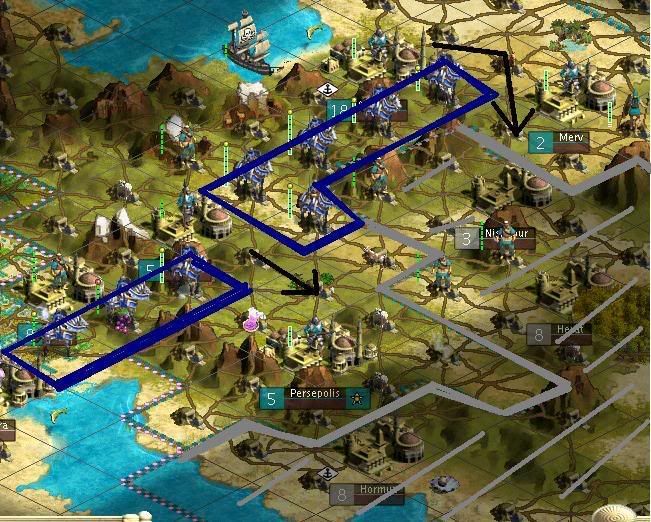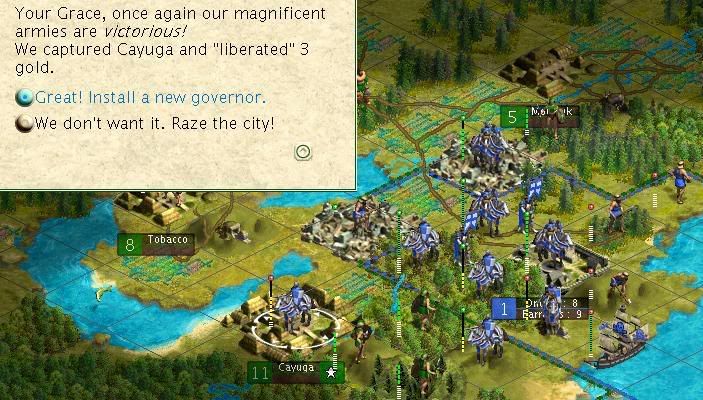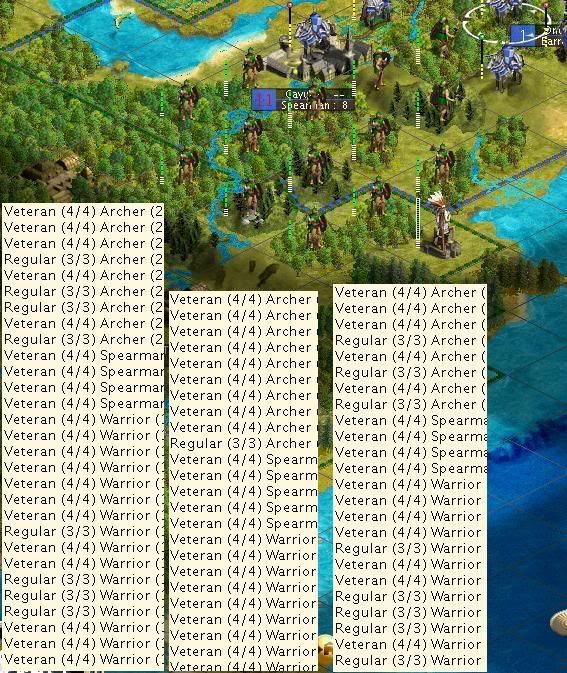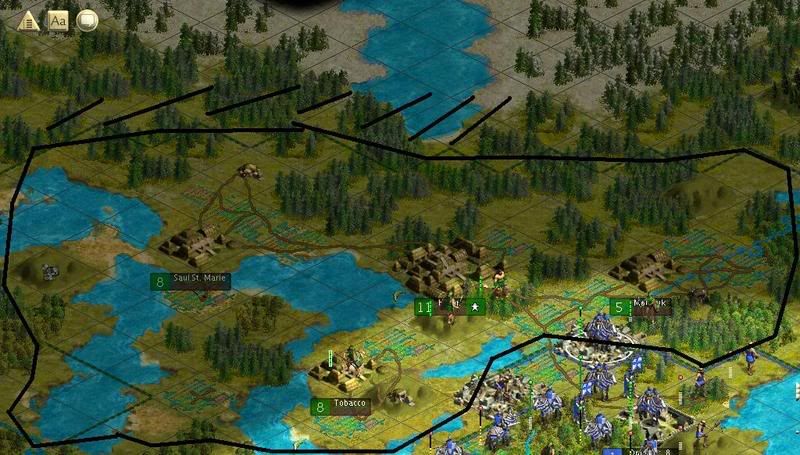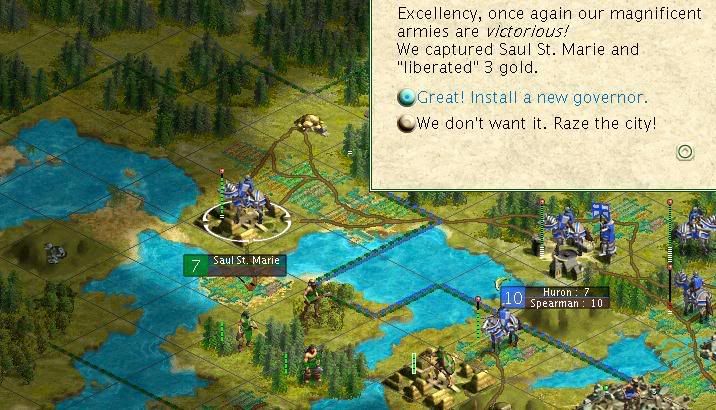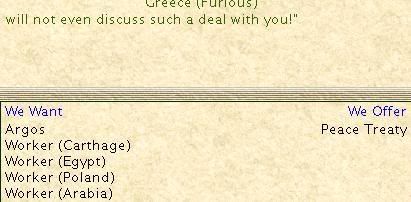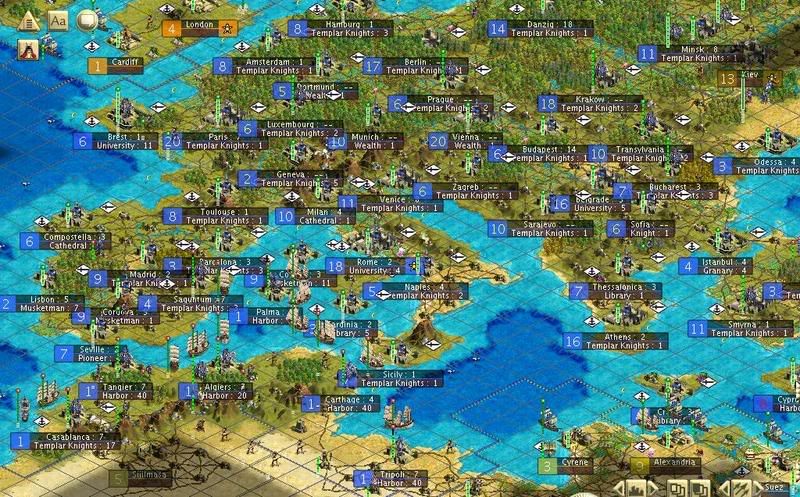=== 320 BC ===
This period begins with the Aztecs and Iroquois signing a peace treaty. You can't trust ANY barbarian tribes, it seems.
German Teutons also noticed the battles of Nishapur and Herat in Persia. The Persians lost both, and word was sent to abandon Persepolis and retreat to northern Persia and the Caucusus - regions which were easier to maintain, and ones Germany intended to sieze in the future.
And finally, large hordes of Iroquois were seen moving towards Oneida - it seems they had a large reserve to fight back with.
--- Battle of Oneida, 320 BC ---
Once again, Oneida faced Iroquois aggressors. 2400 soldiers lie within reach of the city. Behind it was a force of 31,000 men. The frontal force was cut down to 600 by artillery fire. They were cut down without casualty by Templar Knights.
Oneida was secure once more, but in the coming decade another battle would occur, one that would hopefully end the constant on-and-off sieges.
-- Battle of Cayuga --
The self-righteous, corrupt Cayuga government had to be dealt with. Germany sent some of it's Templars to take the city of the same name. 800 enemy soldiers were slaughtered, while Germany lost 500 Templars. At the cost of another 500 Templars, the garrison was exterminated - and the government officials inside with it. Cayuga, the 'capital' of the Confederation, had fallen into German hands. The divide between North and South widened.
Germany was NOT happy with what occurred in Cayuga. 2 out of every 3 citizens fought against the German occupation, using guerilla tactics. The Kaiser was informed, and compromised with the more liberal sides of his empire by stating Cayuga was to be burned, but the people were to be notified and forcefully dispersed.
Cayuga was burned within a week, small villages remaining. The majority of the 700,000 people fled - and formed a military force of 51,400 soldiers. Combined with the force nearing Oneida, this was a total of 75,400. The Cayuga people were(hopefully) throwing their whole weight at Germany.
Even though they lacked a city to call home, the Cayuga realised they had to crush Germany if they ever intended to rebuild their ancestral homeland and unity.
---The New Confederation---
With the destruction and pillaging of Cayuga City and the forced dispersion of it's inhabitants, the center of power shifted northwards. Huron to the north was now by far the largest city, rivalling Cayuga in size. It was the capital of the Northern Confederation, which simply called itself the Confederation now. Sault Ste. Marie kept it's word and applied for membership, later becoming a member.
The new Confederation was radically different. Intellectuals had noticed the constant failure of the Elderly Council, and chose to form a new governmental system. The Council was stripped of all power in the new Confederation, but it was kept as an institution of heritage, but lacked any real power. A new ruler with near-absolute power - a Despot - was installed on the European model. Beneath him, a "People's Council" was created. People popularly elected these representatives. They had no real power of their own, but they kept the leader informed of what his subjects believed.
The Confederation of the Iroquois was now a Despotic state which kept the people's interests - on paper at least - at heart. As well, the Confederation was a Confederation only in name - it had a highly centralised and powerful government. If anything, it was more of a unitary state. But the "Confederation" title was kept to keep conservatives and patriots happy - and also present the image of local government.
Tobacco was torn by civil strife. Conservatives wanted to maintain the status quo, and possibly work out a peace with Germany. Radicals desired to join Germany itself, pointing at their excellent standard of living and education. A mixture of patriots and progressives/liberals wished to join the new Confederation, pointing to it's equality among it's members, and the good deal of political voice the people had. After a short civil war lasting about a year, Tobacco joined the Confederation. The Iroquois were reforming, and Germany poised itself to stop the new Confederation from becoming a real power.
--- Demise of the New Confederation ---
Germany planned to attack the Easternmost city of Mohawk. The Confederation was gaining too much power. Already it's armies had marched against the resurgent local tribes, and it had conquered Michigan. It expanded to the iron rich hills of the west, and gained small chunks of territory in the East and North. Fringe tribes were forced to pay tribute to the powerful rulers in Huron.
600 dead Templars and 800 dead Iroquois spearmen later, Germany had entered the city and occupied it. The Kaiser commissioned a new band of Templars - the Mohawk Legion. Germany also fought against 800 spearmen in the forests a bit further south - and an ENTIRE Templar unit was lost! Hundreds of Templars died in the battle. The thousand or so Templars who died were commemorated with a post-war plaque. In retribution, the Western Holy Legion only lost 100 men when it killed 800 spearmen inside the city of Huron.
A smaller band of soldiers was sent to take over Huron...and they lost only 100 to kill the remaining 400 men inside. Huron had fallen. With their second city of 700,000 captured, the Iroquois people - regardless of political unit - realised their darkest day was coming.
--
With their impressive speed and maneuverability, Templars advanced on Saul Ste. Marie. 800 spearmen died without German casualties, and the city fell just like the others. Tobacco was shocked at the speed of the conquest. The "glorious" Federation it had just joined had collapsed in less then a year. And the people there knew Germany would turn towards them for their next victim.
--
Saul Ste. Marie's fall gave large quantities of gold and iron to the German Reich in North America. In the coming decades, we would battle it out with the Southern Hordes for mastery of the continent.
 Amazing story (been following for a while).
Amazing story (been following for a while). 
 Amazing story (been following for a while).
Amazing story (been following for a while). 

 Next turn, we'll be deploying huge numbers of troops in North America, where we will conquer and raze the Iroquois core. Once the Iroquois are dealt with, we intend to build up our base in North America. Once we're large enough(and have a wall of cities from the Gulf of Mexico to the Pacific, blocking expansion of other powers), we'll tackle the Aztecs for Panama. And once the Aztecs are dealt with, the Inca will be destroyed too. We'll have the land and power to take on China and India once we accomplish that.
Next turn, we'll be deploying huge numbers of troops in North America, where we will conquer and raze the Iroquois core. Once the Iroquois are dealt with, we intend to build up our base in North America. Once we're large enough(and have a wall of cities from the Gulf of Mexico to the Pacific, blocking expansion of other powers), we'll tackle the Aztecs for Panama. And once the Aztecs are dealt with, the Inca will be destroyed too. We'll have the land and power to take on China and India once we accomplish that.









